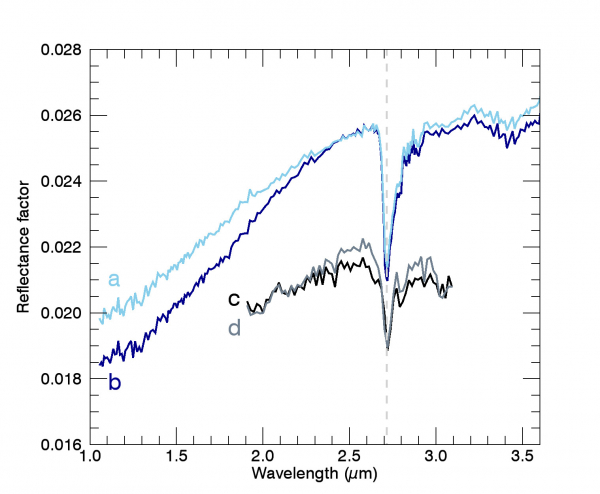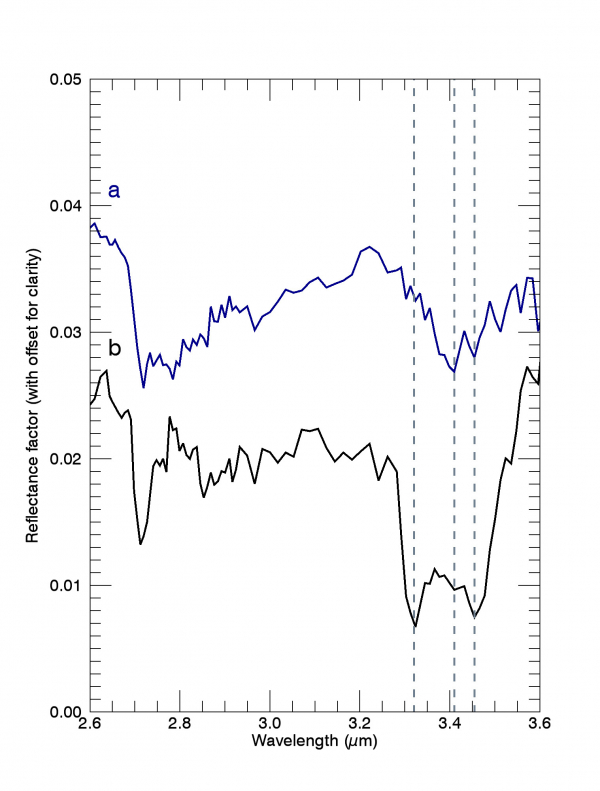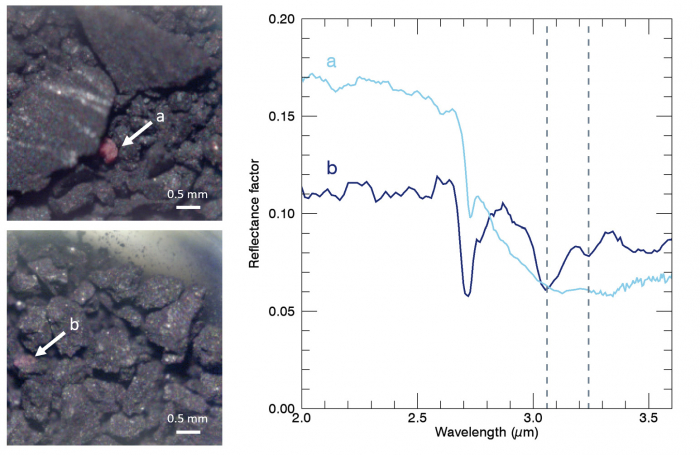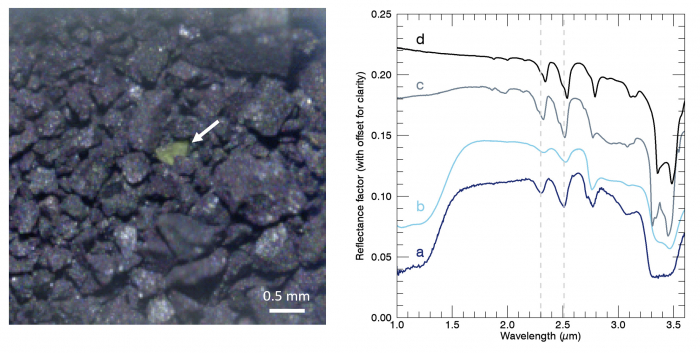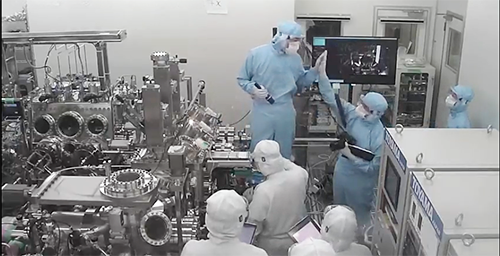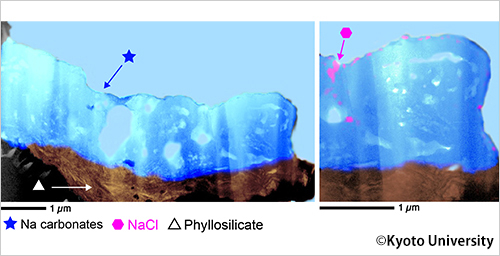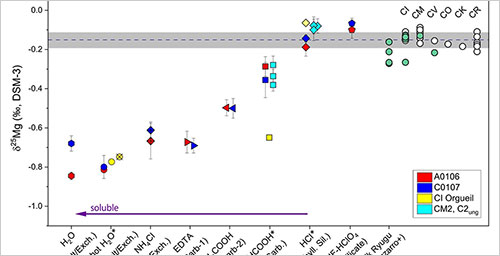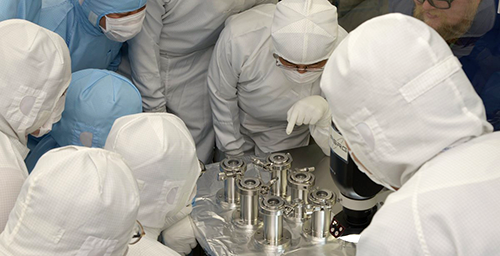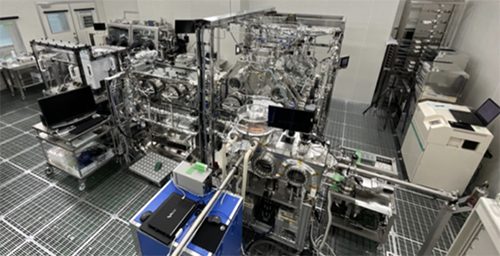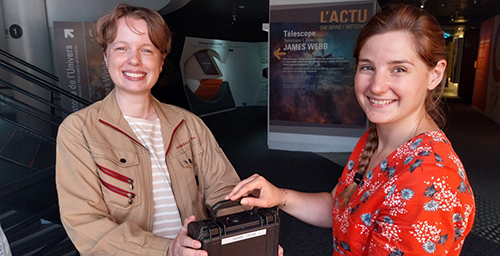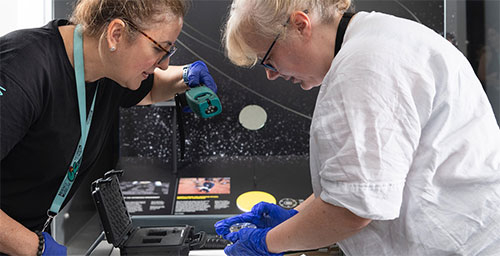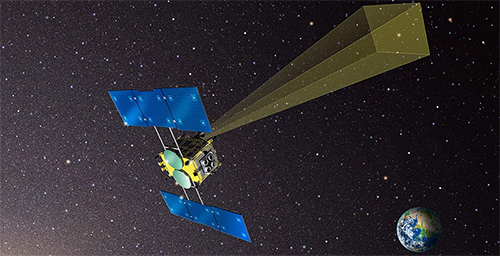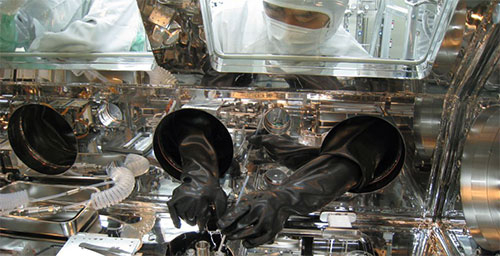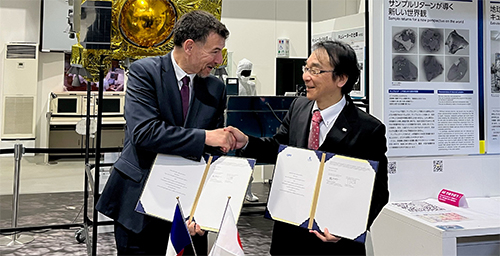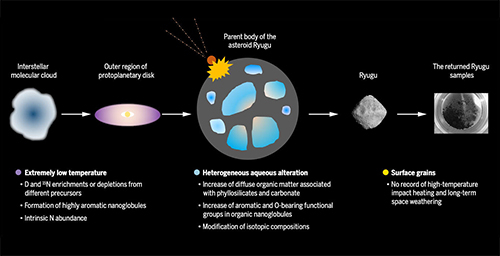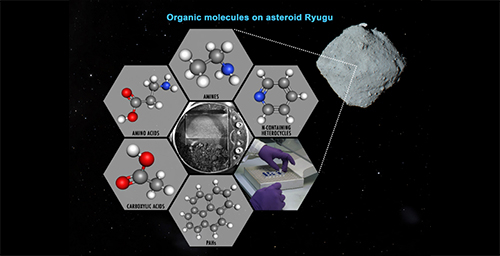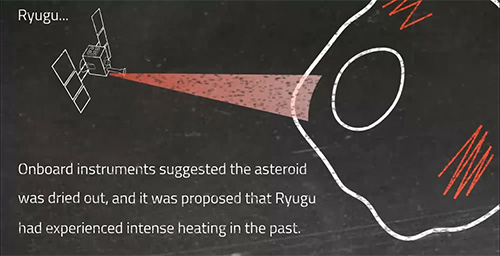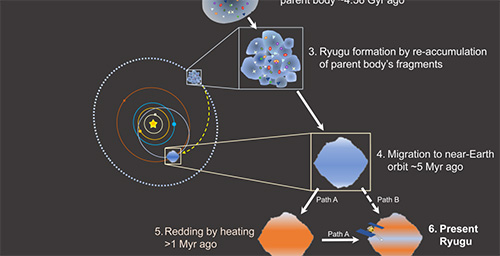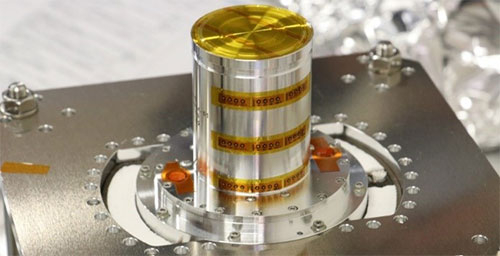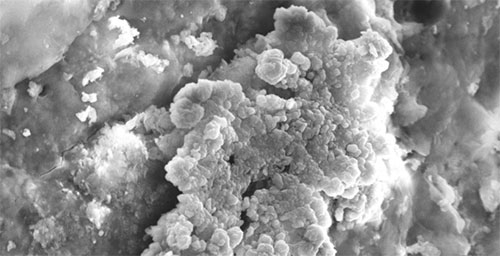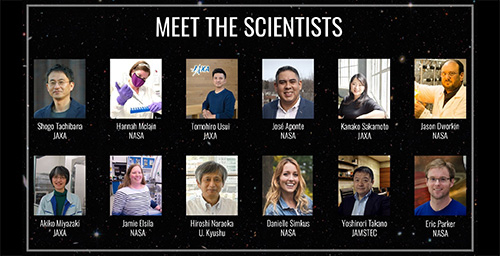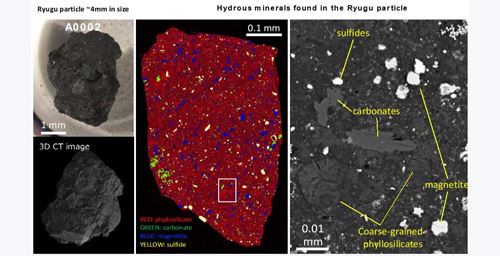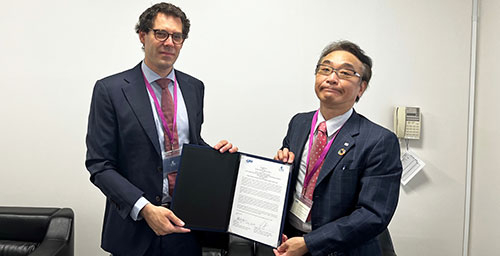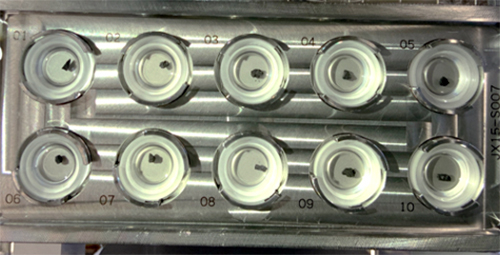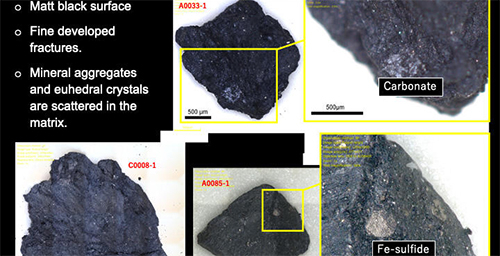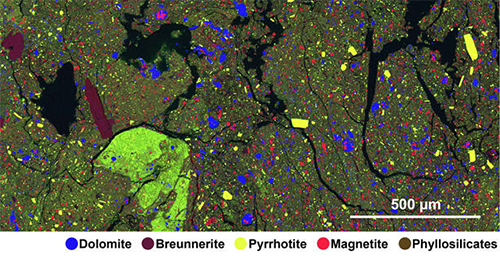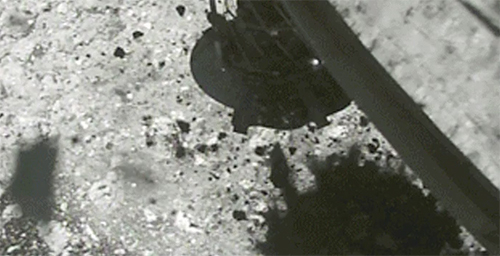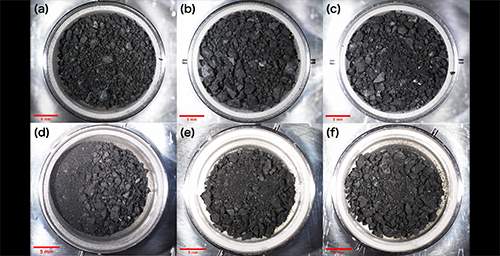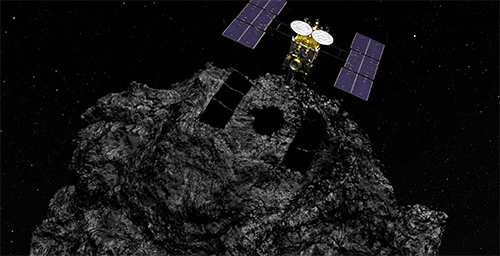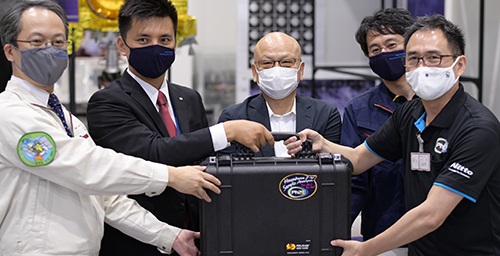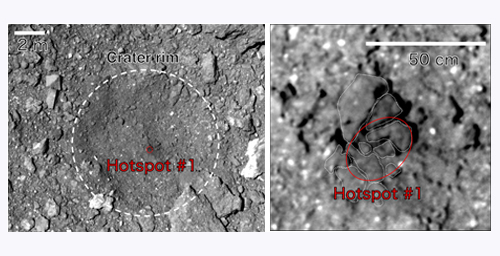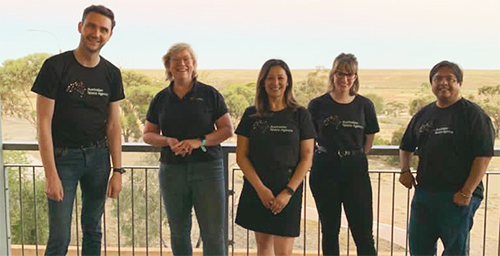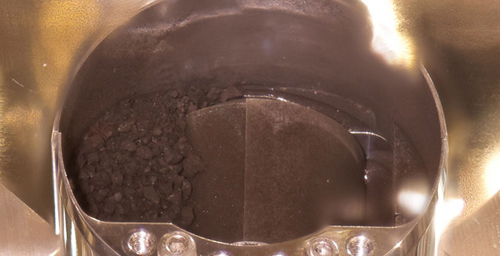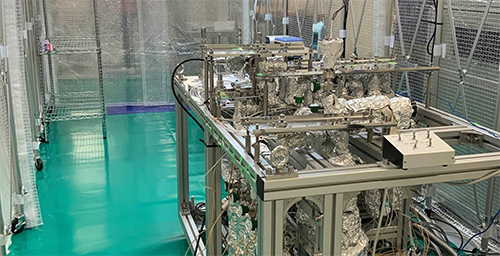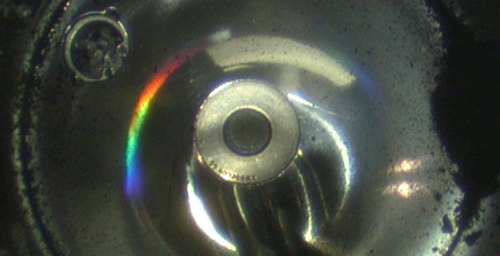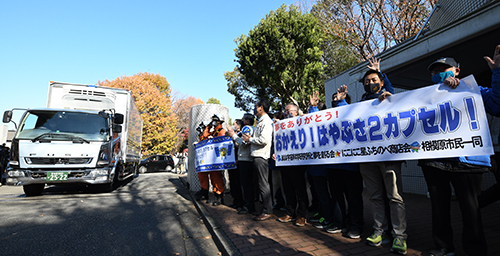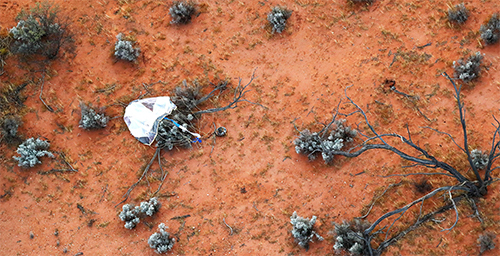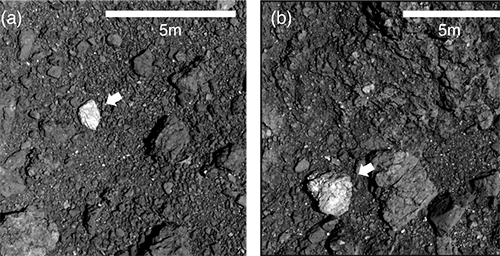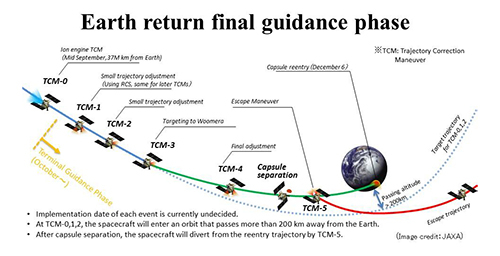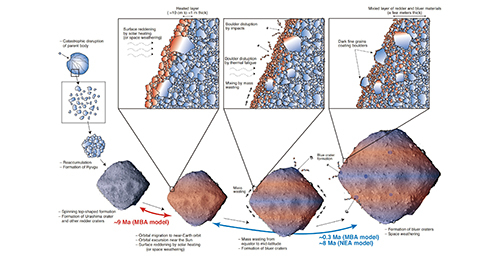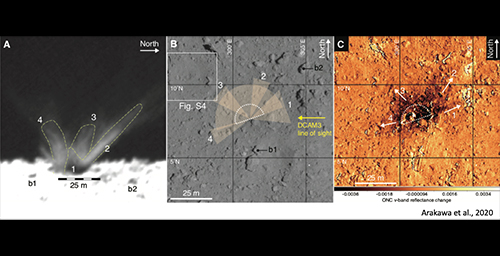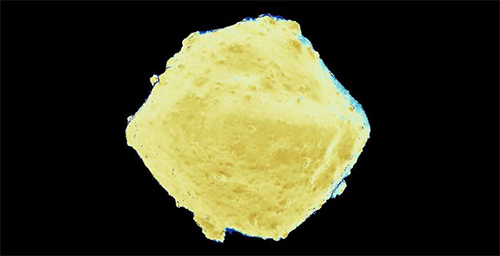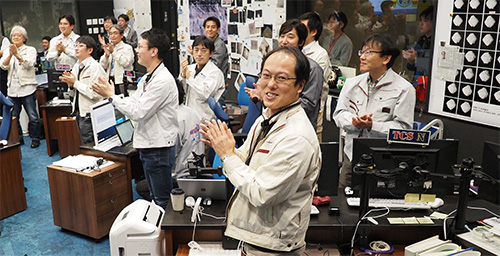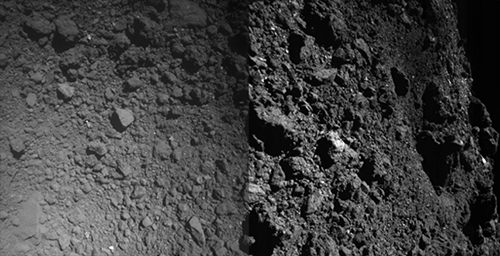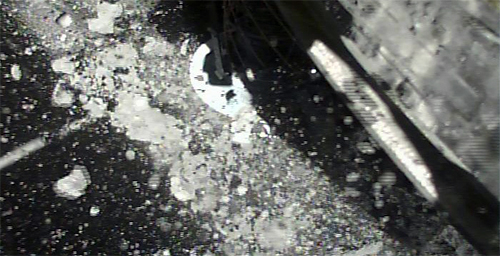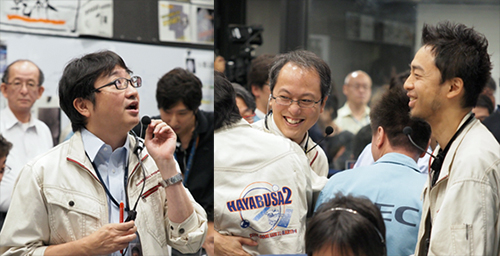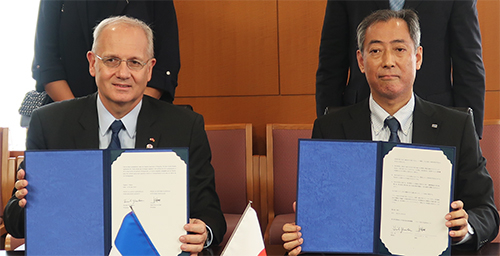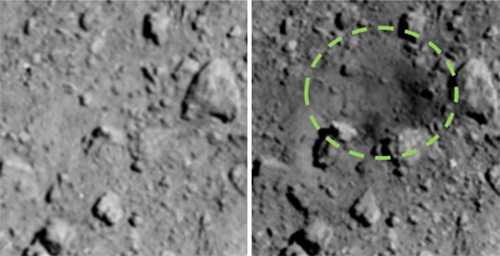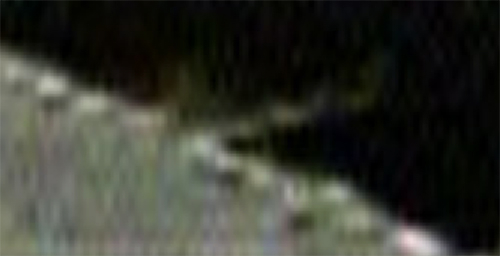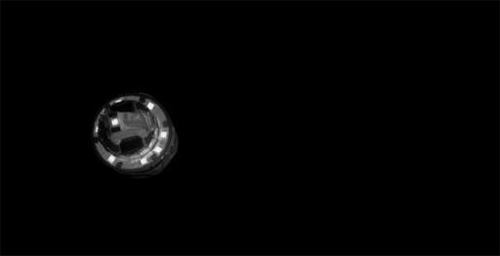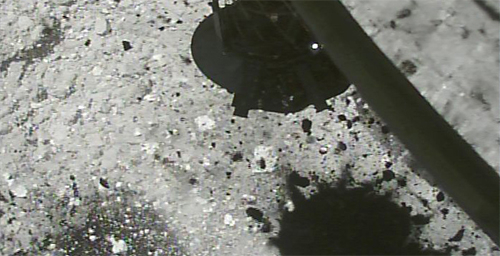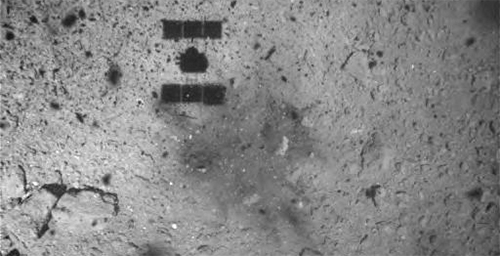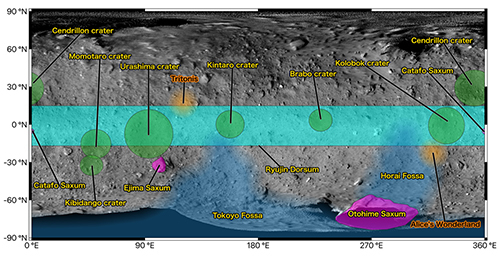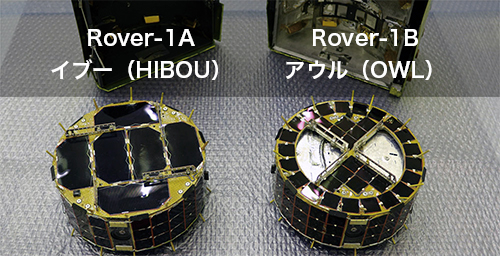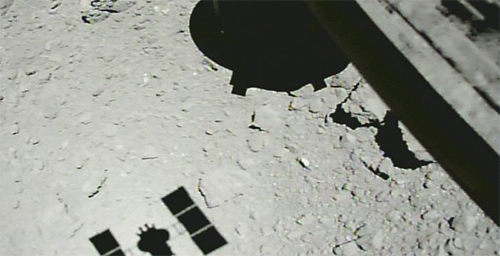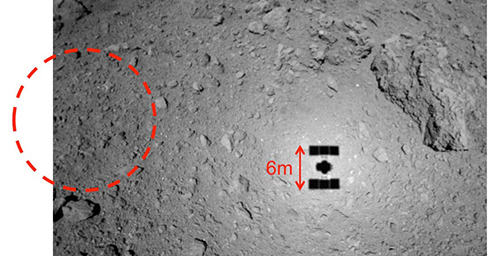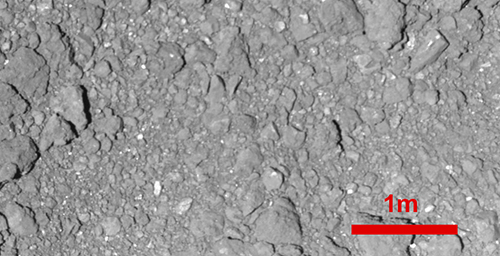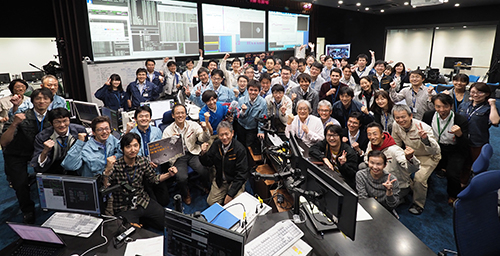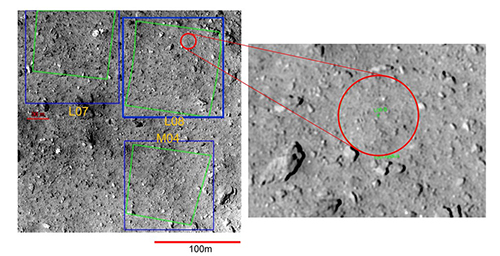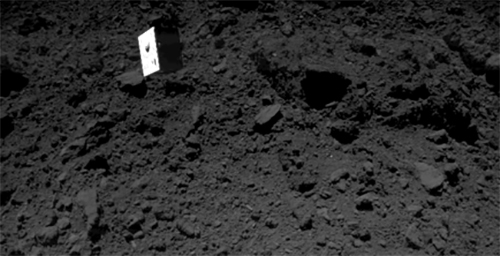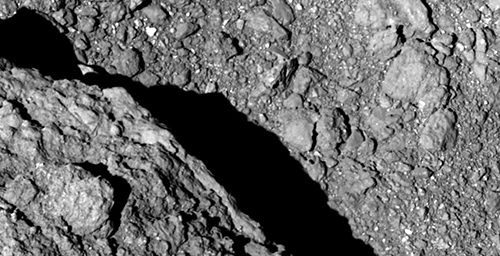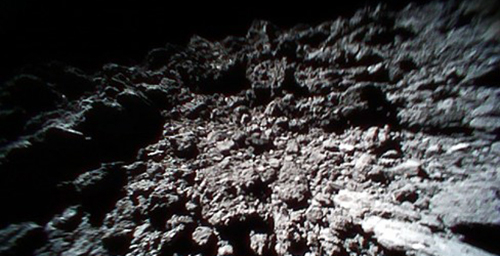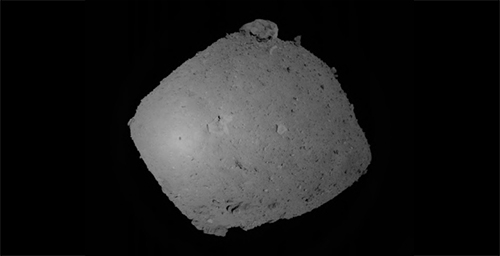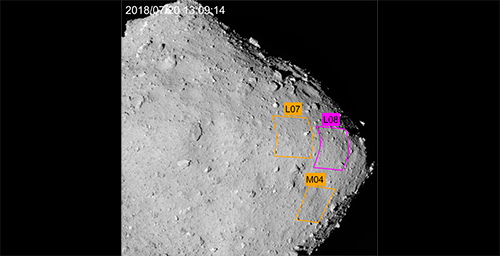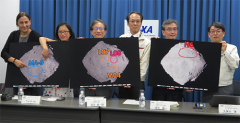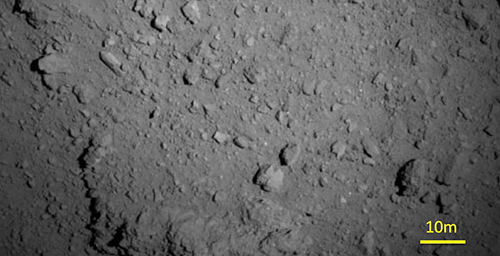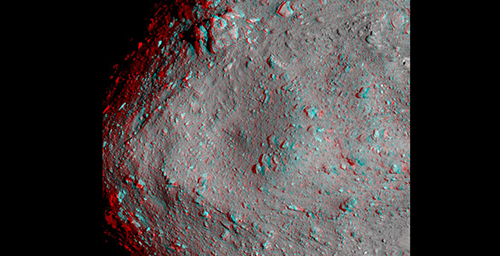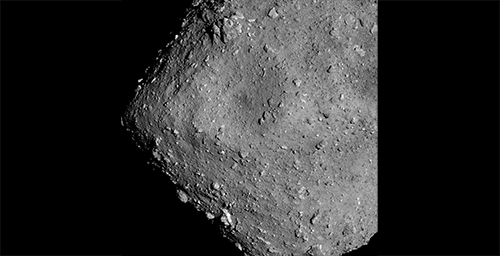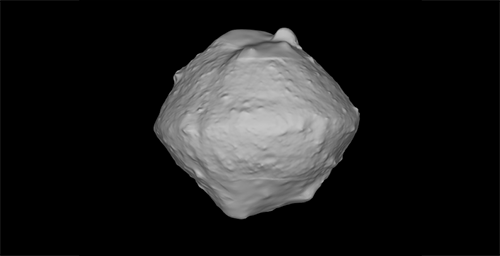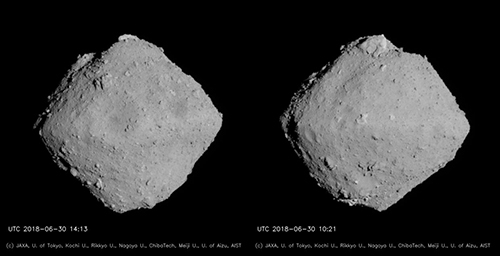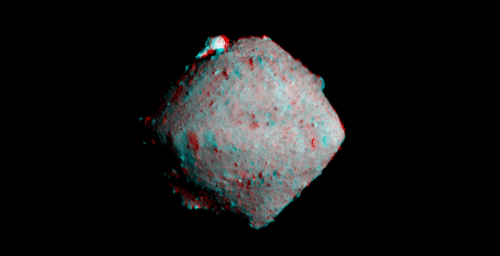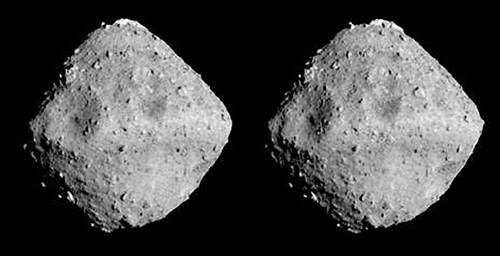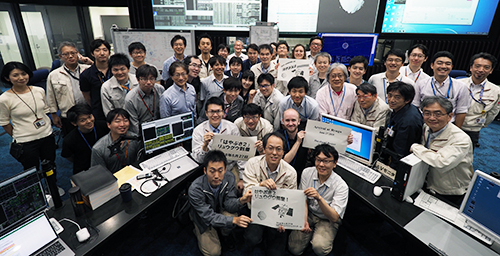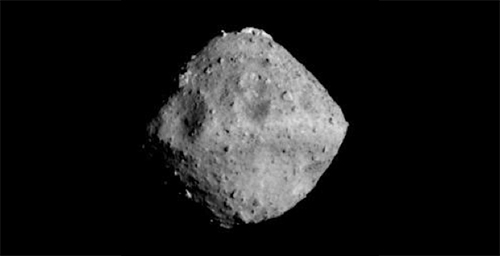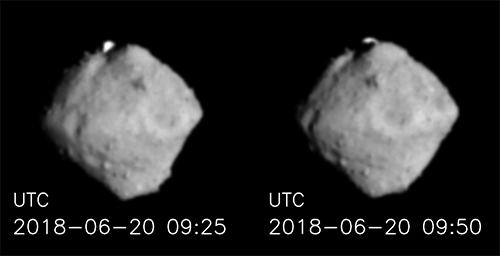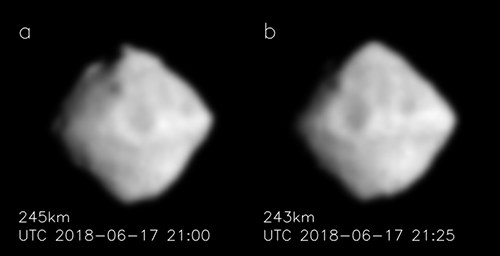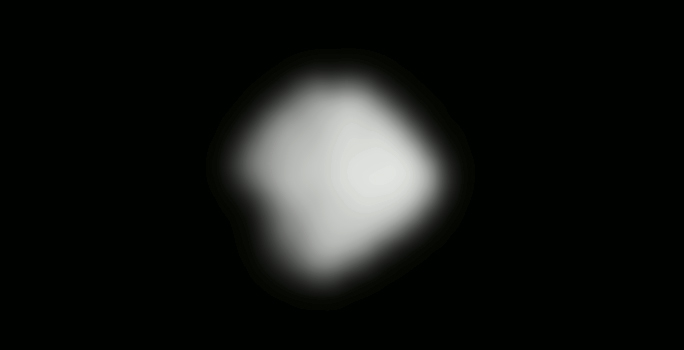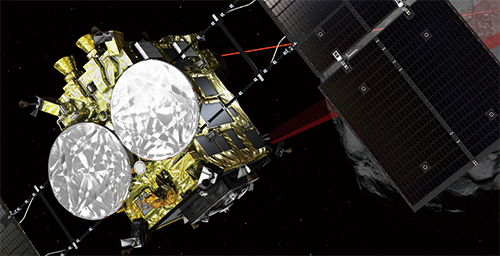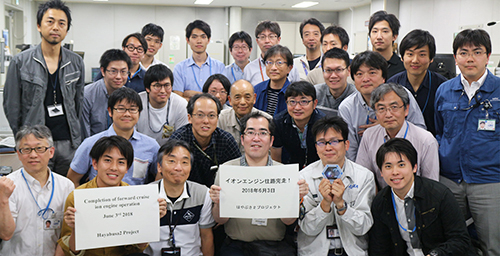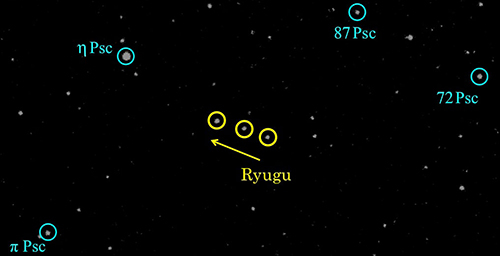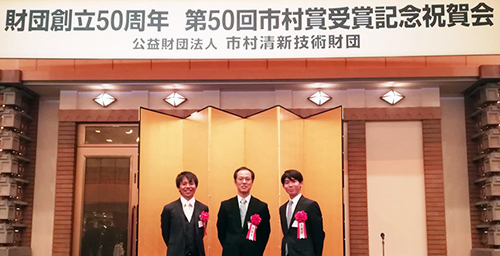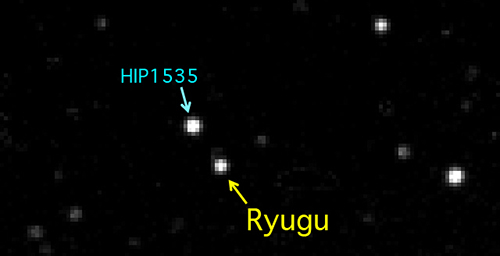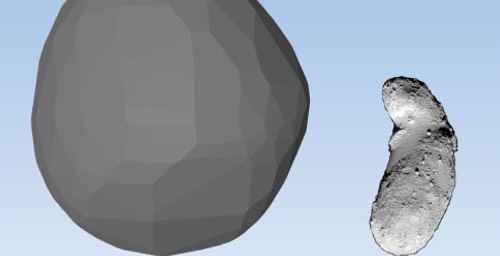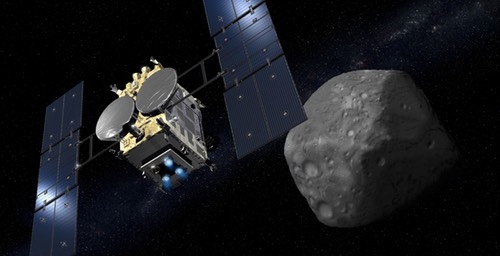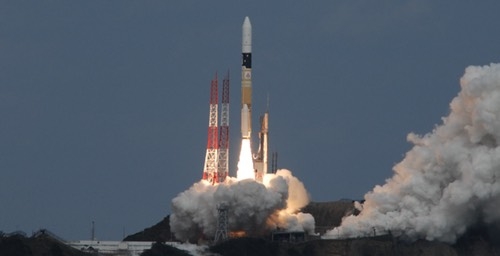Overview
In order to understand how the Solar System formed, and a habitable planet like the Earth was born, it is essential to investigate the characteristics of celestial bodies that best preserve the minerals and molecules present in the early era of the Solar System when the planets were forming. JAXA's Hayabusa2 mission returned a sample from the surface of asteroid Ryugu, a primitive asteroid class (C-type asteroid※1) that is thought to contain large quantities of volatile components such as water and carbon [1, 2]. The return of the sample to Earth made it possible to analysis the characteristics of Ryugu using ground-based laboratory equipment.
The retuned sample was stored at JAXA's Extraterrestrial Sample Curation Center, where a non-contaminating and non-destructive initial description was first performed. The infrared spectroscopic microscope, MicrOmega, that was developed by the French Institut d'Astrophysique Spatiale (IAS) was a key component in this analysis. By observing the sample with MicrOmega in near infrared wavelength bands (0.99 - 3.65µm) with a spatial resolution of tens of µm, it was possible to investigate the minerals and molecules that make up the sample. Strong absorption at a wavelength centered at 2.7µm observed throughout the sample suggests the presence of OH-rich components, indicative of the presence of hydrous minerals that are formed in reactions of minerals with water. Absorption was similarly observed at 3.4µm throughout the sample, which suggests the presence of organic matter. In addition, taking advantage of MicrOmega's high spatial resolution allowed the detection of components rich in carbonates and NH groups on scales of 1mm or less.
The Ryugu sample should retain both the initial material of volatile-rich dust particles gathered from the primitive Solar System disc that surrounded the young Sun, and the material that has undergone changes in the asteroid body as dust accumulated. Through application of further sophisticated analysis methods, the hope is to use these components to decipher the evolution of matter in the early Solar System.
Background
Hayabusa2 succeeded in collecting two samples from different surface locations on the C-type asteroid Ryugu, and returned to Earth on December 6, 2020. The first collection was from the surface layer of Ryugu, and the second from a site where ejecta had been deposited from the generation of a crater formed by an artificial collision experiment, and is therefore expected to include subsurface material [3]. The first and second collected samples were respectively stored in chamber A and C of the sample return container and are referred to here as the "bulk A" and "bulk C" samples.
After returning to Earth, the samples were taken to the curation facility at JAXA's Institute of Space and Astronautical Science, and the initial description began. An overview of the initial description results are described in Yada et al. [4]. Here, we look at the initial description with the spectroscopic microscope, MicrOmega. The initial description of the returned sample with MicrOmega allowed near-infrared hyperspectral microimaging to be performed for the first time in history; that is, spectral measurements in a wavelength range that includes the absorption bands of water and organic matter, were performed for each individual grains or localized regions of particles at high spatial resolution, in addition to averaged values over the entire field of view. The results from this will provide information to groups such as the initial analysis teams, who will carry out detailed analysis in the summer of 2021, and to create a catalogue for the announcement of opportunity scheduled for 2022.
About MicrOmega
MicrOmega [5] sequentially illuminates the sample at different wavelengths of monochromatic light using an acousto-optical tunable filter (AOTF) that scans through wavelengths over the near infrared range (0.99 ~ 0.36µm) with a wavelength width of 10 to 20nm. An area of about 5 x 5 mm2 is imaged with a two-dimensional detector (HgCdTe detector with 256 x 250 pixels). The resolution is about 22.5µm/pix, and a reflection spectroscopic spectrum of up to 400 wavelength channels can be acquired for each pixel. Since the illumination intensity per pixel is weak (≤10-8 W/pix) and there is no contact with the sample, the analysis is both non-destructive and non-contaminative. It is possible to detect the characteristics of major minerals and molecular species / functional groups (for example, mafic minerals, altered phases, ice (OH group), aliphatic/aromatic (CH group) and nitrogen compounds (NH group)) that are found in primitive meteorites [6 - 9].
Observation results from the bulk sample
The contents of chambers A and C in the Hayabusa2 return sample container were each divided into three dish-shaped sample holders (A1 to A3, C1 to C3) and MicrOmega analyzed each holder to determine the average characteristics of the sample. The acquired data first went through de-noising and calibration processes [10]. The spectrum obtained by averaging the samples bulk A and bulk C over scales of several mm is shown in Figure 1. This result is almost the same as that achieved with Fourier transform infrared spectroscopy (FT-IR) reported in Yada et al [4]. In addition, the spectrum resembles that of asteroid Ryugu averaged over scales of several meters that was measured by the near-infrared spectrometer, NIRS3 [11], onboard the Hayabusa2 spacecraft. In both the NIRS3 and sample data, the reflectance is 2 - 3% over the full wavelength range, also in good agreement with the results from the spacecraft's onboard optical navigation cameras, ONC [11,12], and is consistent with the classification of Ryugu as a C-type asteroid [13,14]. There is also a strong and sharp absorption band with a central wavelength of 2.715±0.005µm (hereafter, "2.7µm band"), which is specific to the OH group and also visible in the characteristics of the NIRS3 spectrum.
There is no significant difference between the results from bulk A that was collected from the Ryugu surface layer, and that of bulk C, which is thought to contain subsurface material. However, the absorption depth in the returned sample for the 2.7µm band is 12 - 18%, which is deeper than that from NIRS3 (Figure 1, [11, 15]). It is possible that this discrepancy is due differences in the equipment itself, but may also be caused by different illumination conditions from sunlight when observing the surface of the asteroid from the spacecraft, the effect of shade, or fractures such as small cracks that were created during sampling. In all cases, the spectral characteristics of the bulk sample from observations from both ONC and NIRS3 confirm that Ryugu has a low reflectance of 2 - 3% over nearly the entire asteroid, and the narrow absorption in the 2.7µm band is likewise almost uniform. This good agreement means that the bulk sample on the scale of several mm can be considered representative of the surface material across Ryugu.
In addition to absorption in the 2.7µm band, the bulk sample also shares a common absorption band feature with a depth of 2 ~ 3 % in the wavelength range of 3.3 ~ 3.5µm (Figure 2, hereafter, "3.4µm band") due to various organic materials (CH group). A weaker absorption band is at 3.06µm with additional faint absorption in the vicinity (collectively referred to as the "3.1µm band", herefter), which is specific to ices and ammonia (NH group).
Figure 1: Typical spectra with MicrOmega of Bulk A (a) and Bulk C (b) samples, compared with the near infrared spectrometer, NIRS3, at the surface and (c) and close to where the impact experiment formed a crater (d). The NIRS3 spectrum is normalised at 0.02 at the wavelength of 2 µm. Vertical dashed line indicates the position of the maximum absorption wavelength recorded by MicrOmega (taken from Figure 1 in Pilorget et al. 2021).
Figure 2: Comparison of the CH-rich spectrum for (a) a localized spot within Bulk A and (b) a typical carbonate-rich spot, showing the differences in the 3.4µm band. Both are average spectra over 3x3 pixels. The vertical dashed lines are at 3.32µm, 3.41µm and 3.455µm to highlight the variations in the position and shape of the absorption bands (taken from Figure 2 in Pilorget et al. 2021).
Spatial resolution observation results
The ability to analyze on scales of less than 1mm resolution with MicrOmega allows improved measurement accuracy of the differences between individual grains and of local areas within a grain, allowing variations to be detected in the shape of the absorption band spectrum and central wavelength which can then be discussed in more detail. In fact, the same non-uniformity that was observed on the surface of Ryugu [16] by the camera (MASCam) mounted on the small lander, MASCOT※2, was identified. In general, the grains have a low reflectance and angular shape with sizes of at least 50µm. No spherical granular structures such as chondrules that are seen in meteorites, have been found.
With highly accurate spectroscopic observations being possible for individual grains, it was found that most of the grains show the characteristics of aliphatic organic matter [17,18] with a prominent feature in the 3.4µm band due to the stretching of CH2. The absorption at 3.41µm dominates over absorption at 3.38µm that would originate from CH3 (Figure 2a), suggesting that the aliphatic carbon chains are long (high degree of polymerization) [18]. For grains with sizes of 100µm (Figure 3b), the reflectance in the 3.1µm band is as high as about 10%, deep absorption is found in the 2.7µm band (~45%) and a combined absorption band from 3.06µm, which is strong, and 3.24µm, which is weaker, suggesting a phase rich in hydroxylated nitrogen [19,20], such as NH4 silicates or NH4 hydroxide-rich organics.
Spatial resolution observation result: carbonate detection
In addition to the above features which were common across many grains, the presence of carbonates was also detected. This is noteworthy as the presence of carbonates is reminiscent of water alteration. Individual grains with sizes of several tens to several hundreds of µm, which is less than 1% of the total sample, possess inclusions in the grains that show the characteristics of carbonates, as opposed to aliphatic organics substances, in the 3.4µm band. The spectra of these grains shows that the carbonate takes up about 5% of the grain surface, so it is highly possible that the carbonate is also present in a large number of grains as finer particles. The largest carbonate-rich grain was found in sample holder A1 with a size of 400µm and the whole grain shows the characteristics of carbonate. This grain shows the absorptions at 2.3µm and 2.5µm, and a strong double peak (Figure 2) or trapezoid (Figure 4) at 3.3 to 3.5 µm, that are characteristic of carbonates, as well as reddening at wavelengths of 1.6µm or less (the reflectance increases at longer wavelengths) [21]. This reddening is thought to be due to the effect of Fe2+, which can be coupled to other cations such as Mg and Ca by alteration. The reddening is seen in large carbonate grains with sizes over 100µm, but appears weak in smaller carbonate grains suggesting that these carbonates are Fe2+ poor. On the other hand, the location of the double peaks at wavelengths of 3.32 and 3.45µm are constant and show the same chemical properties for all the measured carbonates. This implies that the carbonates may originate from similar precursors, but undergone different degrees of alteration to produce the diversity in the redness. There is the possibility that a large number of Ca-rich carbonates may be present at fine particles with sizes less than 50µm, the measurement limit of MicrOmega, as is often found in meteorites. This will be investigated in the high-resolution initial analysis.
Spatial resolution observation results: detection of hydroxide salt
Other features detected included that for hydroxide, which can also be important evidence for aqueous alteration. The feature has a wide 3µm absorption band and a narrow 2.7µm band, which is comparable to the OH group, as shown in Figure 3a. This has been found in both bulk A and bulk C sample, although only in a few inclusions and grains. Compared to the bulk sample, the spectra show additional weak absorption around 2.1 ~ 2.2µm and the OH feature whose peak position at 2.7µm is shifted to the longer wavelengths by about 10nm. This suggests a diasapore of an Al-OH-rich compounds, likely aluminum hydroxide. The compound is unlikely to be water due to the lack of clear hydration absorptions at 1.4 and 1.9µm.
Figure 3: Comparison of the spectra of large OH-rich altered grain in the Bulk A sample (a) and NH-rich grain in the Bulk C sample (b). RGB images of the sample near those grains are also shown (left). In the upper left figure, R: 2.5µm, G: 3.2µm, B:3.6µm, and in the lower left, R: 2.5µm, G: 3.05µm, B: 3.4µm. The spectra are averaged over 9x9 pixels in (a) and 6x6 pixels in (b). Vertical dashed lines indicate 3.06µm and 3.24µm, which are the characteristic dips of NH-rich components (taken from Figure 3 in Pilorget et al. 2021).
Figure 4: The average spectrum (100 pixels) for a large carbonate grain in Bulk A taken with MicrOmega (a) compared with reference spectrum from the RELAB library (siderite (b): bkr1cb071a, dolomite (c): bkr1cb017a, calcite (d): bkr1jb549). The RGB image of the region containing the carbonate grain is also shown on the left (R: 2.5µm, G: 2.7µm, B: 3.4µm). The reference spectrum was reduced by 1/6 for easier comparison. The vertical dashed lines are at 2.3µm and 2.51µm (features attributed to carbonates) to highlight the similarities and differences in position and shape of the feature (taken from Figure 4 in Pilorget et al. 2021).
Conclusion
The results above from infrared spectroscopic microimaging of the Ryugu return sample using MicrOmega suggest that Ryugu is a diverse material which is globally rich in OH, CH and NH groups, and also altered phases such as carbonates [22]. Signs of carbonates have also been detected by the exploration of NASA's OSIRIS-Rex mission on asteroid Bennu [23].
The existence of highly volatile components, such as organic matter which likely originates in the outer Solar System, suggests that Ryugu preserves primitive material and substances. At the same time, the diversity found in compounds such as carbonates, indicates the asteroid material also includes altered substances.
The main low reflectance and dark matrix of the asteroid material is thought to be phyllosilicates, but with a wide distribution of CH group-rich inclusions (probably sizes a few µm smaller than a pixel). Components rich in NH groups also seem to be widely distributed. The variety of cation abundances found in the carbonates suggest a mix of different altered phases which are closer to CI chondrites※5, rather than CM chondrites※4 [24,25]. That no chondrule or refractory substances have been found is also reminiscent of the characteristics of CI chondrites.
The Hayabusa2 return sample is one of the most primitive samples available in the laboratory, and is the only valuable collection that will make us reconsider the concept of origin and evolution of the Solar System.
Glossary
※1 C-type asteroid:An asteroid with low reflectance that has a weak wavelength dependence and is mainly distributed in the outer part of the asteroid belt. The reflectance properties resemble that of carbonaceous chondrites, a type of meteorite that is rich in volatiles such as water and carbon, and is considered to be the parent body of these meteorites.
※2 MASCOT:A 10kg-class small lander that was jointly developed by the German Aerospace Center (DLR) and French National Centre for Space Studies (CNES). The lander was mounted on Hayabusa2 and deployed to the asteroid surface, where it observed the surface of Ryugu for 17 hours.
※3 Chondrule:a spherical inclusion of size several mm of less that is found in meteorites.
※4 CM chondrite:a primitive meteorite that is a type of carbonaceous chondrite that contains carbon and water and is rich in chondrules.
※5 CI chondrite:A primitive meteorite that a type of carbonaceous chondrite which is rich in carbon and water, but does not contain chondrules. It has a composition closest to the average elemental composition of the Solar System.
Publication information
Paper title:First compositional analysis of Ryugu samples by the MicrOmega hyperspectral microscope
Journal title: Nature Astronomy, 21 December 2021 (JST)
DOI: 10.1038/s41550-021-01549-z
Corresponding Author:Cedric Pilorget(Institut d'Astrophysique Spatiale, Université Paris-Saclay, CNRS)
Authors:1Pilorget, C.; 2,3Okada, T.; 1Hamm, V.; 1Brunetto, R.; 2Yada, T.; 1Loizeau, D.; 2Riu, L.; 2,3Usui, T.; 4Moussi-Soffys, A.; 2,5Hatakeda, K; 2Nakato, A.; 2Yogata, K.; 2,6Abe, M.; 1Aléon-Toppani, A.; 1Carter, J.; 1Chaigneau, M.; 1Crane, B.; 1Gondet, B.; 2,5Kumagai, K.; 1Langevin, Y.; 1Lantz, C.; 1Le Pivert-Jolivet, T.; 1Lequertier, G.; 1Lourit, L.; 2Miyazaki, A.; 2Nishimura, M.; 1Poulet, F.; 7Arakawa, M.; 8Hirata, N.; 8Kitazato, K.; 2Nakazawa, S.; 9Namiki, N.; 2Saiki, T.; 3Sugita, S.; 2,3Tachibana, S.; 2,6,10Tanaka, S.; 2,6Yoshikawa, M.; 2,6Tsuda, Y.; 11Watanabe, S.; 1Bibring, J.-P.
[1] Institut d'Astrophysique Spatiale, Université Paris-Saclay, CNRS, 91400 Orsay, France,
[2] Institute of Space and Astronautical Science, Japan Aerospace Exploration Agency, Sagamihara 252-5210, Japan,
[3] University of Tokyo, Bunkyo, Tokyo 113-0033, Japan,
[4] Centre National d'Etudes Spatiales, 18 Avenue E. Belin, 31401 Toulouse, France,
[5] Marine Works Japan, Ltd., Yokosuka 237-0063, Japan,
[6] The Graduate University for Advanced Studies (SOKENDAI), Hayama 240-0193, Japan,
[7] Kobe University, Kobe 657-8501, Japan,
[8] The University of Aizu, Aizu-Wakamatsu 965-8580, Japan,
[9] National Astronomical Observatory of Japan, Mitaka 181-8588, Japan,
[10] University of Tokyo, Kashiwa 277-8561, Japan,
[11] Nagoya University, Nagoya 464-8601, Japan.
References
[1] Watanabe, S. et al., Hayabusa2 arrives at the carbonaceous asteroid 162173 Ryugu--A spinning top-shaped rubble pile, Science 364(6437), 268-272, 2019.
[2] Morota, T., et al., Sample collection from asteroid (162173) Ryugu by Hayabusa2: Implications for surface evolution, Science 368(6491), 654-659, 2020.
[3] Arakawa, M., et al., An artificial impact on the asteroid (162173) Ryugu formed a crater in the gravity-dominated regime, Science 368(6486), 67-71, 2020.
[4] Yada, T., et al., Preliminary analysis of the Hayabusa2 samples returned from C-type asteroid Ryugu, Nature Astronomy, this issue. Doi:10.1038/s41550-021-01550-6.
[5] Bibring, J. -P., et al., The MicrOmega investigation onboard ExoMars, Astrobiology, 17(6-7), 621-626, 2017.
[6] Hunt, G.R., Spectral signatures of particulate minerals in the visible and the near infrared, Geophysics, 42(3), 501-513, 1977.
[7] Clark, R.N., et al., High spectral resolution reflectance spectroscopy of minerals, J. GeoPhys. Res., 95 (B8), 12653-12680, 1990.
[8] Clark, R.N., et al., Refelectance spectroscopy of organic compounds: 1. Alkanes, J. GeoPhys. Res., 114 (E03001) 1-19, 2009.
[9] Ferrari, M., et al., Reflectance spectroscopy of ammonium-bearing phyllosilicates, Icarus, 321, 522-530.
[10] Riu, L., et al., The on-ground calibration performances of the hyperspectral microscope MicrOmega for the Hayabusa-2 mission, Planetary and Space Science, 152, 31-44, 2018.
[11] Kitazato, K., et al., The surface composition of asteroid 162173 Ryugu from Hayabusa2 near-infrared spectroscopy, Science 364(6437), 272-275, 2019.
[12] Sugita, S., et al., The geomorphology, color, and thermal properties of Ryugu: Implications for parent-body processes, Science 364(6437), 252-252, 2019.
[13] Binzel, R.P., et al., Physical Properties of Near-Earth Objects. pp. 255-271, 2002.
[14] Vilas, F., Spectral characteristics of Hayabusa 2 Near-Earth Asteroid Targets 162173 1999 JU3 and 2001 QC34., Astron. J., 135 (4), 1101-1105, 2008.
[15] Kitazato, K., et al., Thermally altered subsurface material of asteroid (162173) Ryugu, Nature Astronomy 5, 246-250, 2021.
[16] Jaumann, R., et al., Images from the surface of asteroid Ryugu show rocks similar to carbonaceous chondrite meteorites, Science 365(6455), 817-820, 2019.
[17] Kebukawa, Y., et al., Compositional diversity in insoluble organic matter in type 1, 2 and 3 chondrites as detected by infrared spectroscopy, Geochimica et Cosmochimica Acta, 75(12), 3530-3541, 2011.
[18] Kaplan, H., et al., Reflectance spectroscopy of insoluble organic matter (IOM) and carbonaceous meteorites, Meteoritics & Planetary Science 54(5), 1051-1068, 2019.
[19] Ferrari, M., et al., Reflectance spectroscopy of ammonium-bearing phyllosilicates, Icarus 321, 522-530, 2019.
[20] Ehlmann, B. L., et al., Ambient and cold-temperature infrared spectra and XRD patterns of ammoniated phyllosilicates and carbonaceous chondrite meteorites relevant to Ceres and other solar system bodies, Meteoritics & Planetary Science 53(9), 1884-1901, 2018.
[21] Hunt and Salisbury, Visible and near-infrared spectra of minerals and rocks: II Carbonates, Modern geology, 2, 23-30, 1971.
[22] Endress, M., et al. Early aqueous activity on primitive meteorite parent bodies, Nature 379, 701-703, 1996.
[23] Kaplan, H.H., et al., Bright carbonate veins on asteroid (101955) Bennu: Implications for aqueous alteration history. Science 370(6517), issue 6517, id.eabc3557, 2020.
[24] Endress, M. and Bischoff, A., Carbonates in C1 chondrites: Clues to parent body evolution, Geochimica et Cosmochimica Acta, 60, 3, 489-507, 1996.
[25] De Leuw, S., et al., Carbonates in CM chondrites: Complex formational histories and comparison to carbonates in CI chondrites, Meteoritics & Planetary Science, 45, 4, 513-530, 2010.

